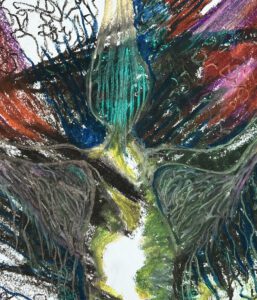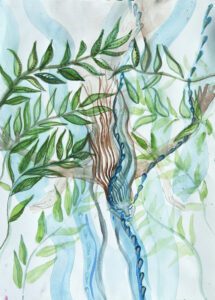Family Dynamics Triggered
While Rebecca was back East last month, she went to visit her friend Annu, an artist whose work we’ve featured in our newsletters before. Annu was also back East, having come from Montana to stay with her mother and sister for several weeks and, much as she loves the two, Annu was feeling triggered by old family dynamics.
Toxic Feelings from Old Patterns
By the time Rebecca got to her, Annu was in something of a state. Rebecca, having just spent a couple of weeks with her own sister and mother, recognized the scenario well: coming to be with family, wanting so much to enjoy loved ones, getting into old but familiar dysfunctional pattern of interacting, trying to practice compassion, acceptance, loving kindness, etc. but still feeling irritated, getting increasingly agitated as this cycle repeated itself.
Loosen Up the Negativity with Art
Rebecca, never far from her art therapy hat, asked Annu is she might make some art as a way to loosen up the toxic hold of negative feelings. Initially Annu balked—partly because she was emotionally exhausted and didn’t want to have to do anything and partly because she felt like trying to compose a picture that captured how she was feeling would just be frustrating.
Don’t Try To Capture It/Just Make Marks
Rebecca suggested that, instead, she just make marks–just take some kind of art supply (preferably something that could take some pressure like pastels, crayons, pencils, etc.) and, without thinking at all about whether it was accurate, make marks that expressed how she was feeling.

Getting It Out
For an intense and absorbed 5 minutes, Annu took dark brown and black pastels to paper and, with a pastel in each hand, pressed the darks colors heavily from the center outwards. She then changed the colors to reds and purples as she continued to fill the page. After about 10 minutes, she lightened the pressure and used the tip of pastels to make fine lines “like filament” around the edge. Finally, she used the handle of a paintbrush to scrape a design of a figure in the layered pastel.
Make A Response To Your Expression
Once she was done, although she felt slightly better, she said that she still felt like she was in her head and a little frustrated so Rebecca suggested she take some aspect of the image and “respond” to it with another image. She again struggled for a moment, wanting to make something more intentional.

Let Your Hands Guide You
Even though Annu wasn’t a client, Rebecca encouraged her to respond like someone might in art therapy—just intuitively let her hand guide her and trust that something would come out. She felt like watercolors were calling her and created a new image that was inspired by the “up and outward” movement of the marks with the oil pastels and the figure she’d “carved’ into them.
Getting in to Flow
She spent about a half- hour getting into “flow” with the watercolors–becoming absorbed with painting the strands of hair and garlands of leaves, painting the piece you see below. By the end of that, she was calmer, more centered. The process of doing the artwork had “metabolized” her angst, i.e. broken it down and transformed that negative energy so that she felt more at ease and grounded.
Not Resolved But Some Relief
Even though Annu was able to get some relief from the intensity of her negativity thought and feelings, she knows that this won’t resolve the dynamics that created them in the first place. This is the first of what art can do for us, expressing difficult feelings can help us “metabolize” them and feel better.
Looking at the Metaphors
The second gift that art gives us is metaphors–looking at the meanings that we can get from the way the art is made and from the image that come emerge.
Some of the Metaphors in Annu’s Process
So although we weren’t doing therapy per se, we did have fun looking at all of the metaphors that emerged from Annu’s two pieces. For example, in the artmaking process of the first image there was the scraping and the vigorous upward and outward movements. In the imagery there was the figure that was carved into the heavy marks, the part that remains untouched in the middle.
Then there was the transition to the more fluid medium of watercolors which literally put her into calm state of flow and the introduction of the strands of leaves that fill the page.
What To Do With These Metaphors
If we were doing art therapy, Annu, being naturally insightful, would explore the meanings of those metaphors and see if they might reveals new information about the dynamics they were about or actions that she could take to address them.
For example, one thing that stuck out to her was that the inside of the figure that she’d carved out of the pastels was “untouched.” This was reminded her of her belief and understanding about herself–that there was a part of her that was unaffected by these challenges, that was “untouched” and pure.
We’ll write more about what she learned from her image and the meaning-making process in upcoming blogs.
Also, click here if you want to attend one of Rebecca’s Art for Self Discovery where you can make some art and then explore the meanings.
